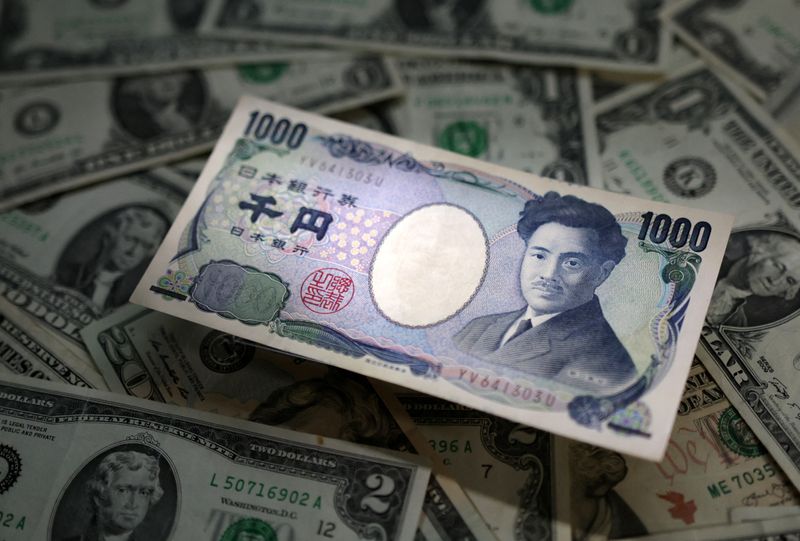Forex
Dollar gains after relatively strong data, Aussie dollar tumbles


© Reuters. FILE PHOTO: Japanese Yen and U.S. dollar banknotes are seen in this illustration taken March 10, 2023. REUTERS/Dado Ruvic/Illustration
By Herbert Lash
NEW YORK (Reuters) – The dollar advanced against major currencies on Tuesday after relatively solid data on U.S. manufacturing and construction in June offset a decline in job openings last month to the lowest level in more than two years.
While an ISM survey offered a tough assessment of U.S. manufacturing conditions, so-called hard data suggested the sector is shuffling along. Federal Reserve data in June showed factory production rebounded in the second quarter, ending two straight quarterly declines.
Meanwhile, U.S. construction spending increased solidly last month and May’s data was revised higher, boosted by outlays in both single and multifamily housing projects, the Commerce Department said.
In a third data set, the monthly Job Openings and Labor Turnover Survey, or JOLTS report from the Labor Department, remained consistent with tight labor market conditions despite the Fed’s hefty interest rate hikes to dampen demand.
The dollar initially slid on the reports, but later rebounded.
“The net between the slightly more positive ISM and the slightly less favorable JOLTs numbers, you wind up in an environment the market doesn’t know what to do,” said Steven Ricchiuto, U.S. chief economist at Mizuho Securities USA LLC.
“The ISM numbers are really net neutral to slightly more constructive, but the reality is the offset in the JOLTs numbers with the continued high levels of openings in terms of what we got in terms of the quit rate,” Ricchiuto added.
Despite the labor market’s resilience, workers showed less appetite to seek greener pastures as resignations dropped by 295,000. As a result, the quits rate, viewed as a measure of labor market confidence, fell to 2.4% from 2.6% in May.
The , a measure of the greenback against six major currencies, rose 0.344% to a fresh three-week high.
Earlier, the Australian dollar fell sharply after the Reserve Bank of Australia left cash rates unchanged and the yen slid to a three-week low as tweaks by the Bank of Japan to its yield curve control policy continued to weigh on the currency.
The yen has swung wildly since Friday, when the BoJ began what may be a slow shift from decades of massive monetary stimulus. The central bank offered to buy 10-year Japanese government bonds at 1.0% in fixed-rate operations instead of the previous rate of 0.5%.
“When you look at all the major central banks, everyone has a firm handle on what the Fed is doing, the ECB and BoE,” said Ed Moya, senior market analyst at OANDA in New York. “It’s Japan that is really where all the focus is going to shift.”
The adjustment to Japan’s yield curve control policy is going to be the focus for the rest of the year, Moya added.
“Everyone is going to be watching all these key levels, such as 1.45, and when will we really get that strong hawkish signal from the BoJ?” Moya said.
The yen weakened 0.75% at 143.35 per dollar.
The Australian dollar posted its biggest daily decline since March after the central bank held rates at 4.1% for a second month, saying past hikes were cooling demand but more tightening might be needed to curb inflation.
The fell 1.61% versus the U.S. dollar at $0.661 to wipe out a 0.87% gain in July.
Private surveys showed that Asia’s factory activity shrank in July, as the region’s fragile recovery takes a hit from slowing global growth and weakness in China’s economy.
The euro fell 0.12% to $1.098 as markets now price in a pause in rate hikes by the European Central Bank. Euro zone inflation fell further in July and the bloc returned to growth in the second quarter with a greater-than-expected expansion.
Sterling last traded at $1.2774, down 0.49% on the day.
Money markets now see a 60% probability that the Bank of England will hike rates by 25 basis points on Thursday. [IRPR]
Currency bid prices at 4:14 p.m. (2014 GMT)
Description RIC Last U.S. Close Pct Change YTD Pct High Bid Low Bid
Previous Change
Session
Dollar index 102.2300 101.8900 +0.34% -1.218% +102.4300 +101.8400
Euro/Dollar $1.0982 $1.0997 -0.15% +2.48% +$1.1003 +$1.0952
Dollar/Yen 143.3600 142.2700 +0.78% +9.36% +143.5400 +142.2150
Euro/Yen 157.42 156.45 +0.62% +12.22% +157.4900 +156.4300
Dollar/Swiss 0.8753 0.8720 +0.38% -5.34% +0.8777 +0.8715
Sterling/Dollar $1.2775 $1.2835 -0.49% +5.61% +$1.2840 +$1.2742
Dollar/Canadian 1.3285 1.3189 +0.74% -1.94% +1.3300 +1.3188
Aussie/Dollar $0.6612 $0.6719 -1.59% -3.00% +$0.6723 +$0.6603
Euro/Swiss 0.9610 0.9587 +0.24% -2.88% +0.9624 +0.9578
Euro/Sterling 0.8594 0.8565 +0.34% -2.83% +0.8606 +0.8551
NZ Dollar/Dollar $0.6147 $0.6210 -1.03% -3.20% +$0.6217 +$0.6132
Dollar/Norway 10.2080 10.0950 +1.14% +4.04% +10.2480 +10.1370
Euro/Norway 11.2120 11.1382 +0.66% +6.83% +11.2320 +11.1271
Dollar/Sweden 10.6043 10.5178 +0.66% +1.89% +10.6422 +10.5190
Euro/Sweden 11.6465 11.5702 +0.66% +4.46% +11.6580 +11.5685

 Forex3 years ago
Forex3 years agoForex Today: the dollar is gaining strength amid gloomy sentiment at the start of the Fed’s week

 Forex3 years ago
Forex3 years agoUnbiased review of Pocket Option broker

 Forex3 years ago
Forex3 years agoDollar to pound sterling exchange rate today: Pound plummeted to its lowest since 1985

 Forex3 years ago
Forex3 years agoHow is the Australian dollar doing today?

 Cryptocurrency3 years ago
Cryptocurrency3 years agoWhat happened in the crypto market – current events today

 World3 years ago
World3 years agoWhy are modern video games an art form?

 Commodities3 years ago
Commodities3 years agoCopper continues to fall in price on expectations of lower demand in China

 Economy3 years ago
Economy3 years agoCrude oil tankers double in price due to EU anti-Russian sanctions





















